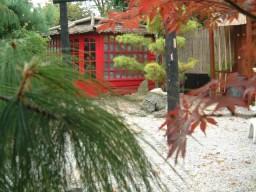
|
JAPANESE HEAVEN |

|

Thirty years in the making, George Nesfield’s Japanese Garden is a work of art of which he can truly be proud. Built to compliment his beloved Japanese Koi, it is a stunning interpretation of the Japanese gardening style and George’s Koi must feel right at home.
When we imagine Japanese gardens we think of peace and tranquillity, of being at one with all the elements of nature and George’s garden achieves this in bucket loads. Standing by the Halfmoon Bridge, listening to the waterfall and watching the fish in the pond below, how could you help but feel positively serene?
If you wanted to design and build your own Japanese garden, you would normally include the following elements: bridges, islands, planting, sand, trees, stone, ponds and waterfalls. Sounds easy, doesn’t it? Stick all these things into the plan and there you have it – a Japanese garden. Unfortunately, art is never quite that easy. Your Japanese style elements must flow together seamlessly, each complimenting the other and, this is the hard part, it must look as natural as possible. The Japanese achieve this by miniaturising the wild landscape and, by copying nature, they create a harmony that is pleasing to the eye.

Strictly speaking, there are three different Japanese gardening styles. The first is the re-creation of the miniature landscape, incorporating all the elements mentioned above. The second is commonly known as the Zen Garden. Zen Gardens seek to copy natural landscapes in a much more abstract and minimalist way. The raked gravel or sand represents the sea with the rocks and pockets of planting representing Islands. Their purpose is largely for quiet reflection and meditation. The third style is the tea garden which has at its centre, the tea ceremony and seeks to suggest a long journey from the entrance to the garden, to the Tea House itself. As such, it will include a series of gateways through which the visitor must pass before finally taking tea.

George Nesfield’s garden doesn’t adhere to any one of these styles.
Rather, it incorporates all three which shouldn’t necessarily work but very definitely does work. It even includes a moongate which, he admits himself, is Chinese in origin, rather than Japanese and this is a true sign of a good garden designer. Good garden design should use a particular style as influence but not be bound strictly by its rules and this is what George does.
Despite being good with his hands – he constructed the moongate, the tea house, the halfmoon bridge and even the lanterns himself – he manages to avoid another common garden design mistake by not allowing the structural elements to dwarf the planting. Throughout his garden the planting compliments and softens the built elements and his planting around both of the ponds is particularly clever. The water seems to flow effortlessly into the rocks and plants just as it would in a natural environment.

He seems to love his plants almost as much as he loves his carp and lovingly tends to an impressive gallery of Bonsai but he also pays attention to height and form and his topiary work combines well with other plants that have been allowed to grow more naturally. His use of colour is perfect for the Japanese style. Brilliant red Japanese Acers provide subtle splashes of colour amongst the many shades of green that form the main structure of the planting and he picks up the red in the Tea House to great effect.
When you look at photographs of George’s garden, it’s not surprising to learn that he’s also an artist on canvas and that local artists in his area visit his garden to sketch and paint. The Japanese view gardens as the highest form of art and I think one of the main purposes of art is to inspire. In fact, I think I might just get rid of that lawn of mine and create my own bit of Japanese heaven. If it looks anything like George’s, I’ll be delighted.
If you want to be inspired, you can view George’s paintings and his garden on his website, George’s Japanese Garden. There is also some good DIY tips and info about Koi.
The photographs in this article have been reproduced by kind permission of George Nesfield and are copyright to him.

You might also want to read...

|
The Japanese Garden at Brisbane Botanics
Despite the proximity of a major road, the garden succeeds in evoking an atmosphere of calm and tranquillity. ...Read more |

|
A Flower Arranger's Garden
Really good garden design is all about the plants. You can be as fancy as you like with the hard landscaping but, without the plants, your garden will have no soul....Read more |
Home
Contact
Submit a Site
Syndication
Write for Us
Back Copy
RSS Feed
Shopping
Garden Designers
Gardening Sites
Gardens to Visit
Gardener's Homepages
Gardening Courses
© Gardenzine. 2006 - 2009. All rights reserved
© Gardenzine. 2006 - 2009. All rights reserved
| Articles by Category | ||
| Current Features | ||
| Gardening Projects | ||
| Garden Design | ||
| Plants and Maintenance | ||
| Classified | ||
| Shopping | ||
| Garden Designers | ||
| Gardening Sites | ||
| Gardens to Visit | ||
| Gardener's Homepages | ||
| Gardening Courses | ||
| Write for Gardenzine | ||
| Submit a Site | ||
| Syndication | ||
| Contact Gardenzine | ||
| Back Copy | ||
| Free online home garden design course | ||
| ||

|
||
|
| ||
| Related Content | ||
| ON GARDENZINE: | ||
| Growing Bonsai | ||
| Chrissie Harten's Flower Arranger's Garden | ||
| Bisbane Botanics | ||
| ON THE WEB: | ||
| Japanese garden composition | ||

|

